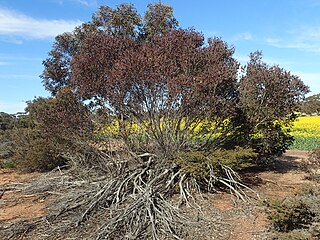
Anigozanthos is a genus of Southwest Australian plants of the bloodwort family Haemodoraceae. The 11 species and their subspecies are commonly known as kangaroo paw or catspaw, depending on their size, and the shape and color of their flowers. A further species, previously identified as Anigozanthos fuliginosus, was separated to a monotypic genus as Macropidia fuliginosa.

Kangaroo paw is the common name for a number of species, in two genera of the family Haemodoraceae, that are endemic to the south-west of Western Australia. These rhizomatous perennial plants are noted for their unique bird-attracting flowers. The tubular flowers are coated with dense hairs and open at the apex with six claw-like structures, and it is from this paw-like formation that the common name "kangaroo paw" is derived.

Anigozanthos manglesii, commonly known as the red-and-green kangaroo paw, Mangles kangaroo paw, Kurulbrang (Noongar), is a plant species endemic to Western Australia, and the floral emblem of that state.

Banksia nivea, commonly known as honeypot dryandra, is a species of rounded shrub that is endemic to Western Australia. The Noongar peoples know the plant as bulgalla. It has linear, pinnatipartite leaves with triangular lobes, heads of cream-coloured and orange or red flowers and glabrous, egg-shaped follicles.

Eucalyptus macrocarpa, commonly known as mottlecah, is a species of mallee that is endemic to the south-west of Western Australia. It has smooth bark, usually sessile, heart-shaped adult leaves arranged in opposite pairs, large red flowers and broad conical fruit.

Eucalyptus rudis, commonly known as flooded gum or moitch, is a species of small to medium-sized tree endemic to coastal areas near Perth, Western Australia. The Noongar names for the tree are colaille, gooloorto, koolert and moitch. This tree has rough, fibrous bark on the trunk and large branches, smooth greyish bark above, lance-shaped to curved adult leaves, flower buds in groups of between seven and eleven, white flowers and bell-shaped, cup-shaped or hemispherical fruit.

Macropidia fuliginosa, the sole species of genus Macropidia, is a perennial rhizomatous flowering plant. A relation of the kangaroo paws, Anigozanthus, which are also endemic to Southwest Australia, it is referred to as the black kangaroo paw. Bearing unusual black and green flowers, it occurs on a coastal plain from Perth to Geraldton.

Anigozanthos humilis is a species of Anigozanthos in the family Haemodoraceae. This flowering perennial plant is endemic to Southwest Australia and widespread in its open forests. Common names include catspaw and common catspaw.

Anigozanthos flavidus is a species of plant found in Southwest Australia. It is member of the Haemodoraceae family. It is commonly known as the tall, yellow, or evergreen, kangaroo paw. The specific epithet, flavidus, refers to the yellow flowers of this plant.

Eucalyptus wandoo, commonly known as wandoo, dooto, warrnt or wornt, is a small to medium-sized tree that is endemic to the southwest of Western Australia. It has smooth bark, lance-shaped adult leaves, flower buds in groups of nine to seventeen, white flowers and conical to cylindrical fruit. It is one of a number of similar Eucalyptus species known as wandoo.

Eucalyptus loxophleba, commonly known as York gum, daarwet, goatta, twotta or yandee, is a species of tree or mallee that is endemic to Western Australia. It has rough bark on the trunk, smooth olive to brownish bark above, lance-shaped adult leaves, flowers buds in groups of between seven and eleven, white flowers and conical fruit.

Eremophila forrestii, commonly known as Wilcox bush is a flowering plant in the figwort family, Scrophulariaceae and is endemic to Australia. It is a many-branched shrub with its branches, leaves and sepals densely-covered with a thick layer of greyish or yellowish hairs giving the plant a felty appearance. Its flowers are cream-coloured to pink and are spotted or streaked dark red. It occurs mostly in Western Australia but also in the far west of South Australia and the Northern Territory. Six subspecies are recognised by the Western Australian Government Department of Parks and Wildlife.

Eucalyptus gardneri, commonly known as blue mallet, or woacal, is a species of mallet with flower buds in groups of between seven and eleven, creamy yellow or pale lemon-coloured flowers and cylindrical to barrel-shaped fruit.

Eucalyptus celastroides, commonly known by the Noongar name of mirret, is a species of eucalypt that is endemic to the south-west of Western Australia. It is a mallee, rarely a tree, and has rough bark on about half of the lower half of its tunk, smooth above, narrow lance-shaped adult leaves, flower buds in groups of seven or nine, white flowers and urn-shaped fruit.

Caladenia busselliana, commonly known as Bussell's spider orchid, is a plant in the orchid family Orchidaceae and is endemic to a small area in the south-west of Western Australia. It is a rare orchid with an erect, hairy leaf and up to three pale yellow flowers. Only about fifty specimens are known and it is threatened by habitat destruction and by too-frequent or too infrequent bushfires.

Xanthorrhoea gracilis, commonly known as the graceful grasstree, grassboy or mimidi, is a species of grasstree of the genus Xanthorrhoea native to Western Australia.

Anigozanthos gabrielae is a species of Anigozanthos in the family Haemodoraceae known as dwarf kangaroo paw. This flowering, rhizomatous, perennial plant is endemic to Southwest Australia and grows on sand in areas which are wet in winter.

Anigozanthos rufus is a grass-like evergreen perennial plant native to the southern coasts of Western Australia. Common names include red kangaroo paw, crimson kangaroo paw, and backdraft.

Anigozanthos bicolor, commonly known as little kangaroo paw or two coloured kangaroo paw, is a grass-like perennial herb native to the south western coastal parts of Western Australia.

Anigozanthos onycis, the branched catspaw, is a rarely seen plant found in Southwest Australia.





















